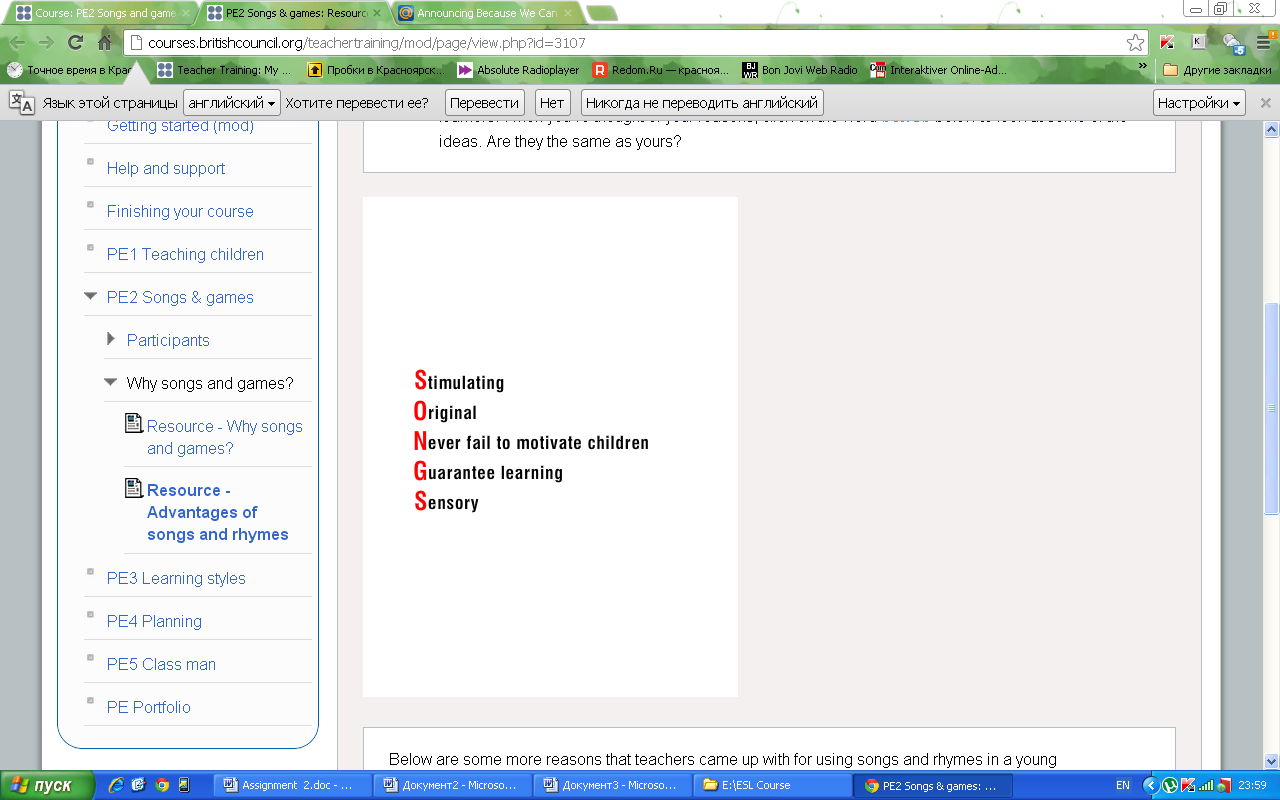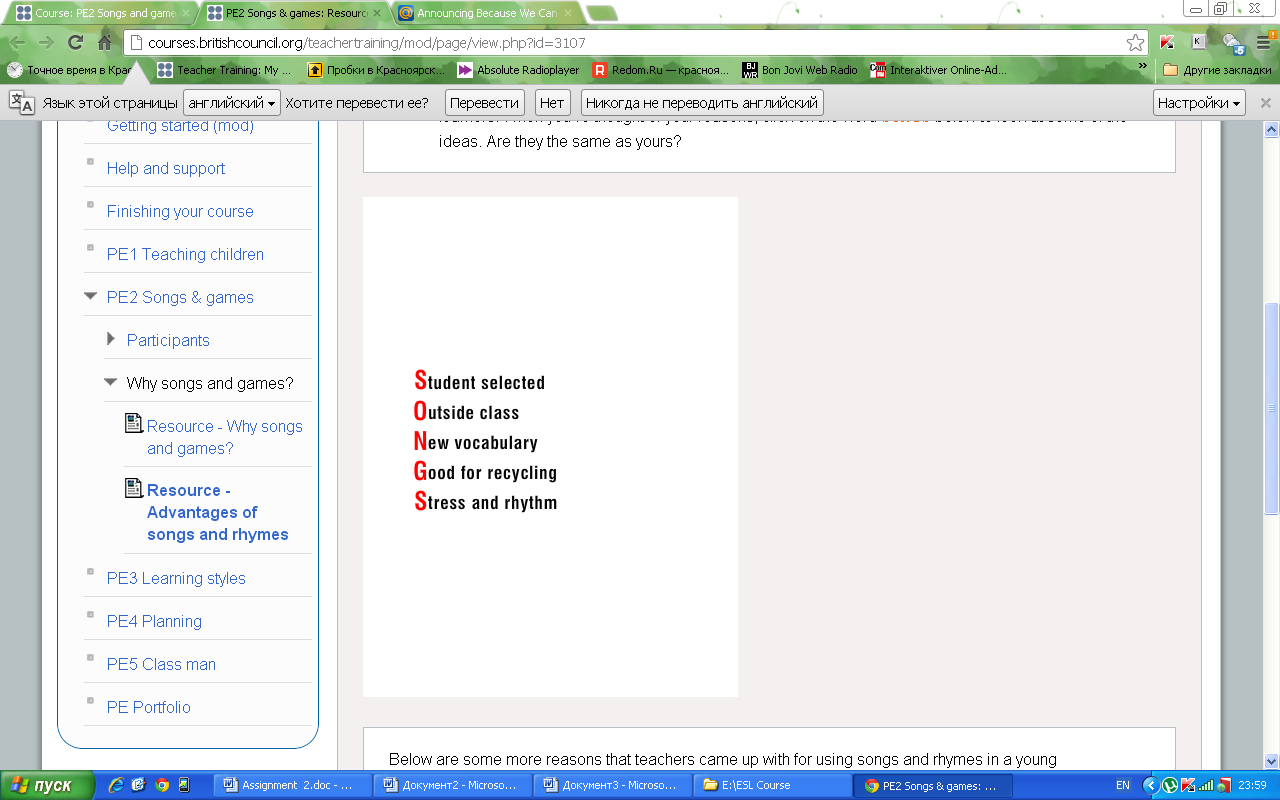
- •Songs and games
- •Learning outcomes
- •Why songs and games?
- •1.1 Why songs and games?
- •1.1 Why songs and games?
- •1.2 To sing or not to sing?
- •1.3 The advantages of songs and rhymes
- •1.3 Advantages of songs and rhymes
- •2.2 Action songs and rhymes
- •This is the way we ...
- •This is the way we say hello
- •2.3 Traditional versus contemporary songs
- •2.3 Traditional versus contemporary songs
- •Pizza and chips
- •3.2 Adapting songs for the language classroom
- •3.1 Commentary - Adapting songs for the language classroom
- •Actions
- •Adding sound effects
- •Substituting other tunes
- •Omission
- •3.2 Adding actions to songs
- •3.2 Commentary - Adding actions to songs
- •The Alphabet Song
- •Other song ideas
- •Final points about songs
- •4.1 Final points about songs
- •4.1 Final points about songs
- •Are the children involved?
- •Is language development integrated into the song?
- •Does it encourage active learning?
- •Games - what and why?
- •5.1 Games - what are they?
- •5.1 Games - what are they?
- •5.2 Why games?
- •5.2 Why games?
- •Purpose, organisation and materials
- •6.1 Purpose, organisation and materials
- •The purpose of playing games
- •Code-control games
- •Communication games
- •Patterns of organisation
- •Materials and equipment needed
- •The Word Chain game
- •Language focus and involvement
- •7.1 Language focus and involvement
- •Competition and Co-operation
- •Uncertainty
- •7.1 Answer key - Language focus and involvement
- •Songs, rhymes and games - things to avoid
- •8.1 Songs, rhymes and games - things to avoid
- •8.1 Songs, rhymes and games - things to avoid
1.3 The advantages of songs and rhymes
We recognise that young learners of all ages enjoy songs and rhymes, but how useful are they for learning?
Decide what you think are the main reasons for including songs and rhymes in lessons. Then read the Advantages of songs and rhymes resource below and check to see if your ideas are mentioned.
1.3 Advantages of songs and rhymes
If you don't use songs or rhymes, maybe one of the reasons is that you teach as you were taught. You will look at how you teach and the effects it has on your students in the Syllabus and lesson planning unit.
Think of as many different reasons as possible why you might use songs and rhymes with young learners. When you've thought of your reasons, click on the word SONGS below to look at some of the ideas. Are they the same as yours?


Below are some more reasons that teachers came up with for using songs and rhymes in a young learner classroom:
They are a flexible resource for teachers. What does this mean? You can use them in many different ways for a variety of language learning activities. They make learning more memorable
The teacher can practise rhythm and stress with the children
Children learn songs and rhymes easily and quickly. They enjoy them and they are good for building confidence
Many songs and rhymes are made of repetitive, set phrases with new words added between these phrases, i.e. ideal for language teaching
Songs and rhymes introduce children in a natural and effective way to English sounds as well as stress and intonation
By using a song or rhyme in class you are giving children a complete text with meaning, even if the student cannot read
If carefully chosen and slotted into your teaching syllabus, songs and rhymes can be used to introduce or practise new language.
2
Types of songs and rhymes
This exercise will take around 20 - 30 minutes.
2.1 Types of songs and rhymes
If you use songs in your classroom, what types do you use? The songs and rhymes for teaching English can be divided into different groups, for example:
Action songs and rhymes (counting, finger, spelling rhymes)
Traditional songs and rhymes
'Pop' and contemporary songs
2.2 Action songs and rhymes
Open the Action songs and rhymes resource below and look at the first group in more detail.
2.2 Action songs and rhymes
Counting rhymes are exactly that - the children sing a song or say a rhyme whilst counting using their fingers.
Watch this video of Raymond using a very well-known counting song, Five yellow bananas. What other actions are involved? Which parts of the song do the children enjoy the most?
Five yellow bananas
Notice how Raymond uses his fingers to show and count, and the way he sometimes holds back from saying the word so that the children can say it instead of him. Another important technique he uses is counting the class in to the beginning of the song - "1, 2, 3" - which means that everybody starts at the same time. If you don't do this, it can sound a bit chaotic.
Once you have used a song like this in your class, you will probably (hopefully!) see the children practising it in the playground or walking around school.
Action songs and rhymes are great if the children are very active or are feeling restless. Finger rhymes like Five Yellow Bananas can be used whilst the children are sitting, whereas other songs, such as "Head, Shoulders, Knees and Toes", are more physical, using the whole body, so it is better if the children are standing up or moving around.
This is the way we ... is an example of a very active song where the children mime the actions as they sing. As you watch, think about how you would use it with your students.
